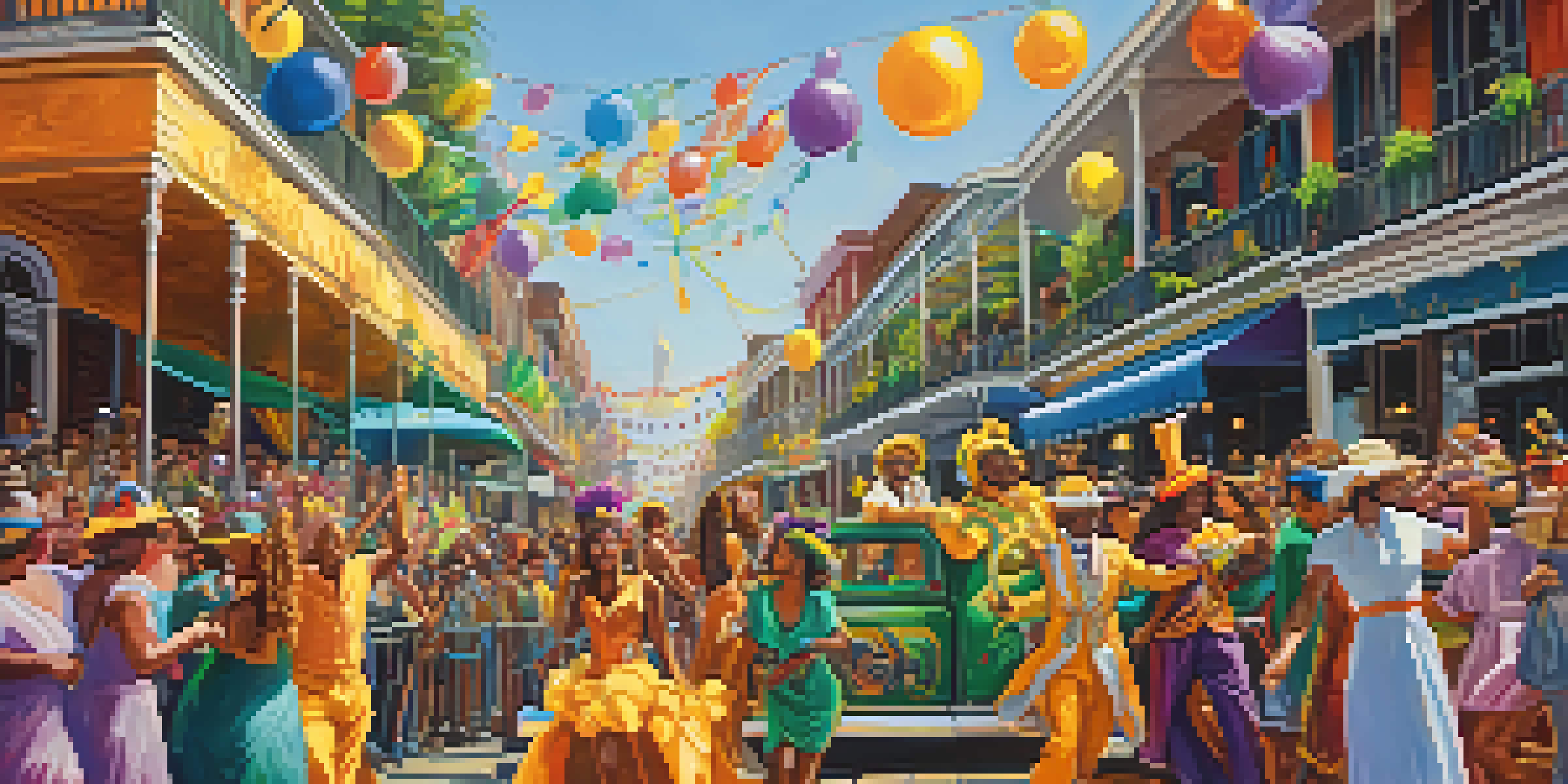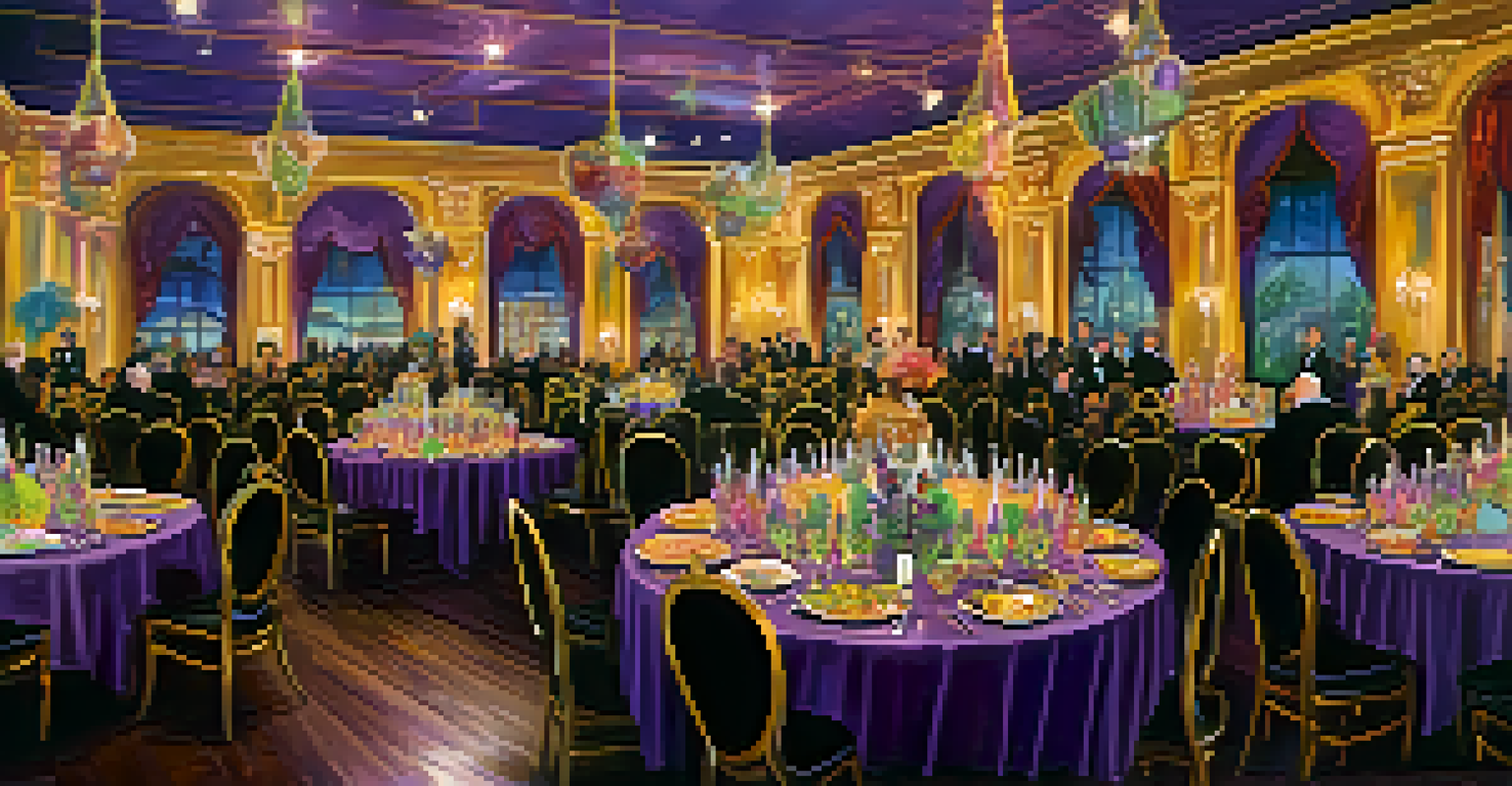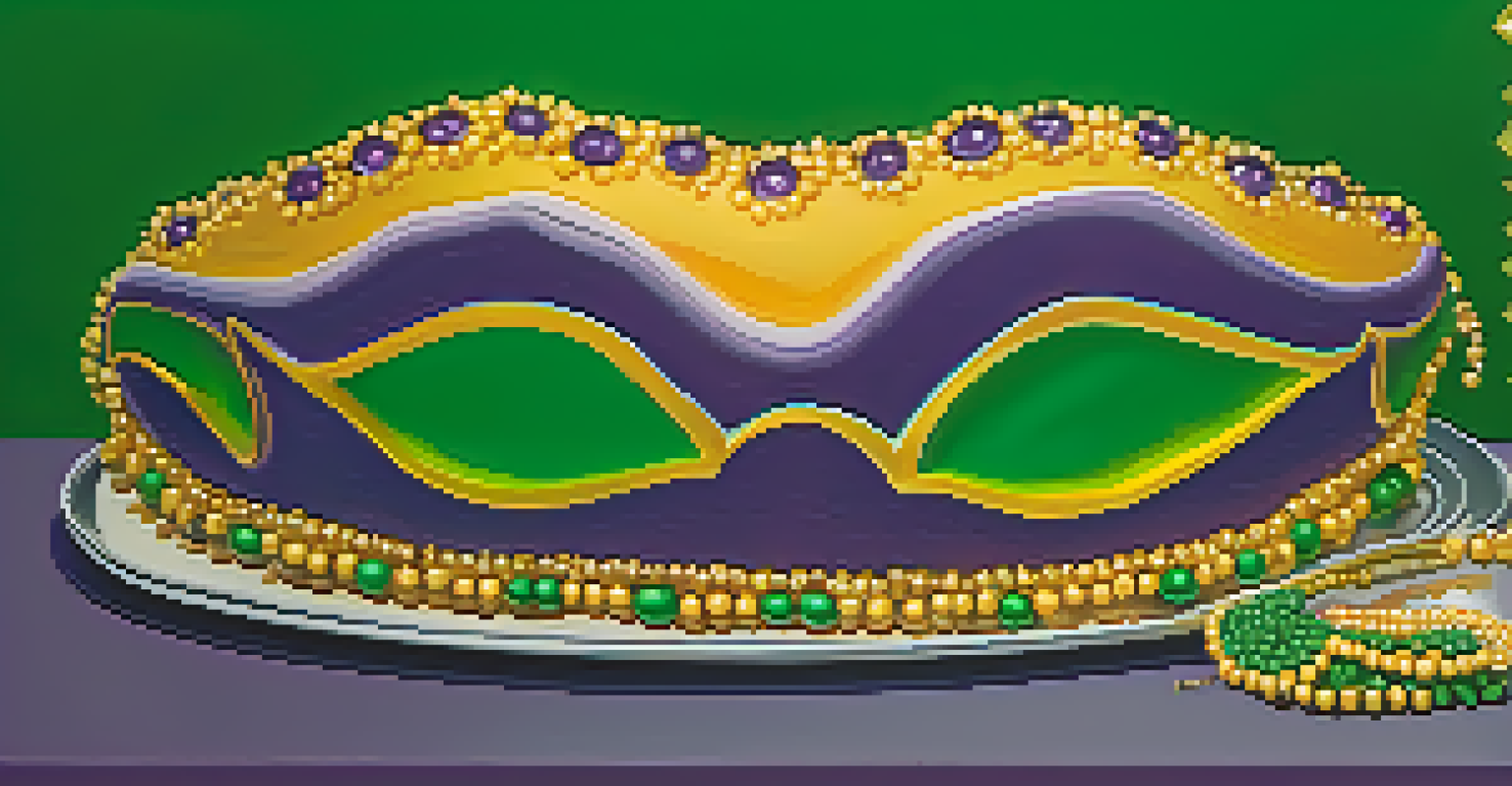Social Events and Balls: Mardi Gras Celebrations Unveiled

The Rich History Behind Mardi Gras Celebrations
Mardi Gras, also known as Fat Tuesday, has deep historical roots dating back to ancient Roman and medieval European festivities. The celebration marks the final day before Lent, a period of fasting in Christianity. Over the years, it has evolved into a vibrant cultural phenomenon, especially in places like New Orleans, where the festival takes on a life of its own.
Mardi Gras is a celebration of life, of the living, and of the community that surrounds us.
In the early days, Mardi Gras was a time for feasting and merriment before the solemnity of Lent. As the tradition spread, various regions added their unique twists, incorporating local customs, music, and cuisine. This rich tapestry of influences has shaped what we now recognize as Mardi Gras celebrations today, making them diverse and multifaceted.
The significance of Mardi Gras extends beyond just food and fun; it serves as a community bonding experience. Families and friends come together to celebrate traditions, create memories, and enjoy the lively atmosphere that defines this festival. Understanding its history helps us appreciate the depth and meaning behind the colorful parades and extravagant balls.
Iconic Symbols and Traditions of Mardi Gras
One of the most recognizable symbols of Mardi Gras is the mask. Traditionally worn to conceal the identity of revelers, masks encourage a sense of freedom and playfulness during the festivities. They also represent the spirit of the carnival—allowing people from all walks of life to come together and celebrate as equals.

Another important symbol is the colorful beads that are tossed from floats during parades. These beads have become a staple of Mardi Gras culture, symbolizing the joy and exuberance of the event. Catching beads is not just a fun activity; it also creates lasting memories and a sense of connection among participants, as everyone cheers and celebrates together.
Mardi Gras: A Rich Cultural History
Mardi Gras has evolved from ancient Roman feasts into a vibrant celebration, particularly in places like New Orleans, combining local customs and community bonding.
The king cake is another beloved tradition, often served during the Mardi Gras season. This sweet, colorful pastry holds a hidden figurine, and whoever finds it is crowned king or queen for the day. This playful element adds to the festive spirit, reinforcing the community aspect of the celebration, as friends and families gather to share in the fun and indulge in this delicious treat.
The Extravagance of Mardi Gras Balls
Mardi Gras balls are the crown jewels of the celebration, showcasing opulence and grandeur. These elegant events often feature elaborate themes, stunning costumes, and lively entertainment. Attendees dress in formal attire, sometimes donning masks, adding an air of mystery and excitement to the evening.
The best part of Mardi Gras is the sense of community and belonging that it fosters among participants.
Many of these balls are organized by social clubs known as 'krewes,' each with its own unique history and traditions. Krewes host their own parades and events throughout the season, culminating in the grand ball. This sense of belonging and camaraderie among krewe members enhances the festive atmosphere, making each ball a memorable experience.
These lavish gatherings often include traditional dances, live music, and gourmet food, creating an immersive experience for guests. The atmosphere is filled with laughter, joy, and celebration, encapsulating the essence of Mardi Gras. Attending a ball is not just about enjoying the night; it’s about being part of a larger cultural narrative that celebrates life, community, and creativity.
Street Parades: A Burst of Color and Energy
One of the most striking features of Mardi Gras is the vibrant street parades that wind through cities like New Orleans. These parades are a feast for the senses, featuring colorful floats, lively music, and enthusiastic crowds. Each float represents a different krewe, showcasing their unique themes and creativity.
As the floats roll by, revelers eagerly await the throws—small trinkets, beads, and other festive items tossed into the crowd. This interaction between float riders and spectators creates an exhilarating atmosphere, with cheers and laughter echoing through the streets. It’s a beautiful demonstration of community spirit, as everyone comes together to celebrate.
Symbols and Traditions Abound
From masks to king cakes, Mardi Gras is filled with iconic symbols that foster a sense of connection and joy among participants.
The parades often feature elaborate costumes, dancers, and musicians, transforming the streets into a vibrant carnival. The energy is contagious, inviting even the most reserved individuals to join the fun. This sense of togetherness and shared joy is what makes Mardi Gras parades an unforgettable experience for attendees.
Culinary Delights: The Flavors of Mardi Gras
Mardi Gras is not just a visual feast; it’s also a culinary celebration that tantalizes the taste buds. Traditional dishes, such as jambalaya, gumbo, and beignets, are staples during this festive season. Each dish tells a story of cultural influences and local ingredients, making the food as rich as the festival itself.
One of the most iconic foods associated with Mardi Gras is the king cake. This colorful pastry is often enjoyed throughout the Carnival season, with its sweet cinnamon flavor and creamy icing. The anticipation of finding the hidden figurine inside adds an element of surprise, making each bite a delightful adventure.
Food is an integral part of the Mardi Gras experience, bringing people together over shared meals and recipes passed down through generations. Whether savoring a plate of crawfish étouffée at a local eatery or enjoying homemade treats at a gathering, the flavors of Mardi Gras create lasting memories and a sense of belonging.
Mardi Gras: A Celebration of Diversity and Inclusion
At its core, Mardi Gras is a celebration of diversity, embracing people from all backgrounds and walks of life. This inclusivity is evident in the variety of traditions, music, and art forms showcased during the festivities. The vibrant cultural tapestry enriches the experience, making it a true reflection of community spirit.
Events such as parades and balls invite participation from everyone, fostering a sense of belonging. Whether you're a local or a visitor, the warm embrace of Mardi Gras welcomes all, encouraging individuals to express themselves freely. This spirit of acceptance is a beautiful aspect of the celebration, creating connections that transcend differences.
Diversity and Inclusion at Its Core
Mardi Gras celebrates diversity, inviting people from all backgrounds to participate and express themselves, creating a rich cultural tapestry.
The celebration also highlights various cultural influences, such as African, French, and Spanish, showcasing the rich history and heritage of the region. This blend of traditions not only enhances the festivities but also serves as a reminder of the importance of unity in diversity. Mardi Gras truly embodies the idea that when we come together, we create something extraordinary.
Planning Your Own Mardi Gras Experience
If you're considering experiencing Mardi Gras for yourself, planning ahead can enhance your enjoyment. Start by researching the various events, parades, and balls happening during the season. Each has its unique charm, so finding the right fit for your interests will ensure a memorable experience.
Accommodation is another important aspect to consider, as hotels fill up quickly during Mardi Gras. Booking early can secure you a comfortable place to stay close to the festivities. Additionally, exploring local dining options ahead of time can help you discover the best culinary delights the region has to offer.

Lastly, don't forget to embrace the spirit of Mardi Gras by getting involved. Whether it's wearing a mask, joining a parade, or sampling traditional foods, immersing yourself in the culture will make your experience even more rewarding. By participating fully, you'll create lasting memories while celebrating this vibrant tradition with others.